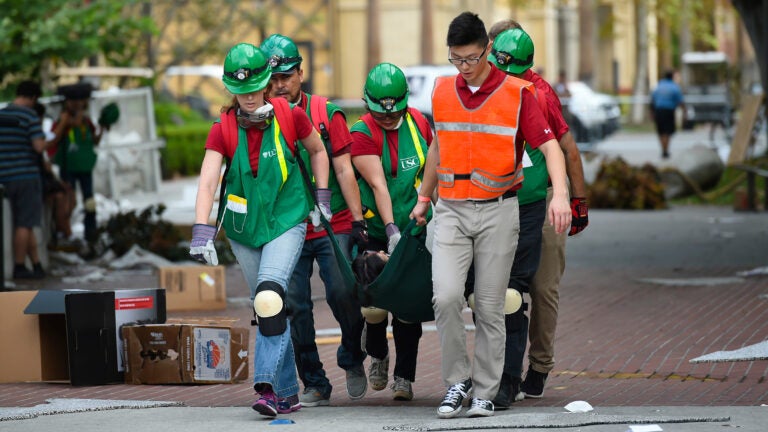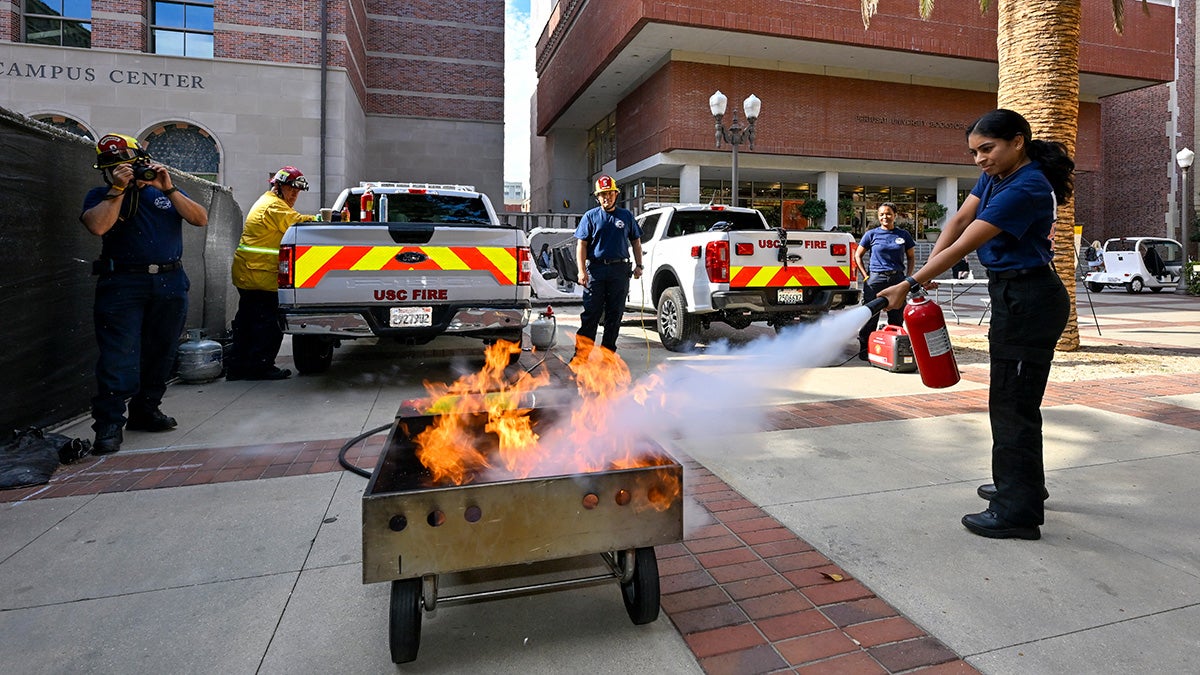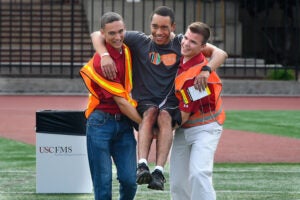
USC emergency personnal transport an actor portraying an injured person during the 2015 ShakeOut drill. (USC Photo/Gus Ruelas)
Science/Technology
Ahead of Thursday's Great ShakeOut drill, the director of the USC-based Statewide California Earthquake Center discusses its expanding role.
Thanks to a recently awarded $6.1 million National Science Foundation grant, the Southern California Earthquake Center has an updated name and a wider remit. Now the Statewide California Earthquake Center, the consortium will expand its "natural laboratory" beyond the San Andreas Fault System in Southern California to encompass the entire Pacific-North America plate boundary in California and the surrounding regions.
Since its founding in 1991, SCEC has been ground zero for earthquake research and outreach for the state and around the world. Based at USC and supported by the NSF, the U.S. Geological Survey and other sponsors, the consortium of over 90 research institutions coordinates interdisciplinary earthquake research to provide useful information for reducing earthquake risk.
On Oct. 19, USC will participate in the 16th annual Great ShakeOut Earthquake Drill that SCEC and key partners created in 2008 in Southern California, and SCEC now coordinates worldwide.
THE GREAT SHAKEOUT
- What: Annual worldwide earthquake drill. USC has participated since the ShakeOut began in 2008.
- When: 10:19 a.m. Thursday, Oct. 19.
- Learn more: Visit USC's ShakeOut website.
To learn more about the new name and other recent developments at SCEC, we spoke with the center's director, Yehuda Ben-Zion, a professor of earth sciences at the USC Dornsife College of Letters, Arts and Sciences.
Congratulations on the recent NSF grant. As part of this funding, SCEC is expanding its domain to include all of California. What does the change mean practically?
SCEC has always had a footprint outside of Southern California - the consortium of over 90 institutions involved in the center means we have global participation and outreach. However, our focused natural laboratory has been the San Andreas Fault System in Southern California, where we have conducted detailed observational studies used to test and develop further models.

The new NSF grant allows us to expand our focused natural laboratory. It now includes Southern, Central and Northern California, the Western Basin and Range province, and the northern part of Baja California. This new footprint includes much more diverse geological domains with different tectonic deformations and faults, different levels of complexity and different styles of failure. This gives us an additional richness of information that we hope will lead to a deeper understanding of earthquakes and the ground motion they generate.
Equally important, the extended domain of the Statewide Center now covers the entire population of California that is at risk from hazardous earthquakes and can benefit from this research. California is home to roughly two-thirds of the earthquake hazard of the entire continental U.S., so it's really an important transformation.
Will SCEC expand its operations beyond USC?
Yes. From SCEC's beginning we have had active collaborators among many institutions in the U.S., including East Coast institutions such as Harvard and MIT [the Massachusetts Institute of Technology], and other countries. For example, scientists from Europe and New Zealand often come to our meetings and participate in our research activities.

However, now that we're statewide the plan is to potentially have a hub in Northern California. We hope this hub will be in Sacramento in partnership with the California Geological Survey, which has been partnering with our research and education activities for a long time. We will continue to be headquartered at USC, but a hub in Sacramento will help us to increase connections with state agencies and coordinate activities focused on Northern California.
How is SCEC improving the way we study earthquakes?
SCEC received another grant recently, from the NSF's Office of Advanced Cyberinfrastructure, that totals $2.5 million over five years for a project led by SCEC, the San Diego Supercomputer Center at [the University of California, San Diego] and the University of Illinois. This project is to establish a science gateway called Quakeworx that will improve the way we analyze earthquake rupture forecasts, which provide information about the likelihood of having earthquakes of different sizes at different locations.
The Quakeworx gateway will facilitate large-scale simulations that include coupled evolution of earthquakes and faults for the first time. This project will simplify the simulations process and the sharing of key results with federal and state agencies, academic institutions and the private sector. How will we do this? By broadening access to simulations codes, data and a range of analysis tools. SCEC will be developing methodologies to extract information from the next-generation earthquake simulations, which will be run by computational tools hosted by the San Diego Supercomputer Center.
Featured Expert
Yehuda Ben-Zion
Expert in Physics of earthquakes and faults, Localization of deformation, Dynamic rupture in geologically-relevant structures, Spatio-temporal seismicity patterns, Analysis of seismic catalogs, High-resolution seismic imaging and Earthquake forecasting






